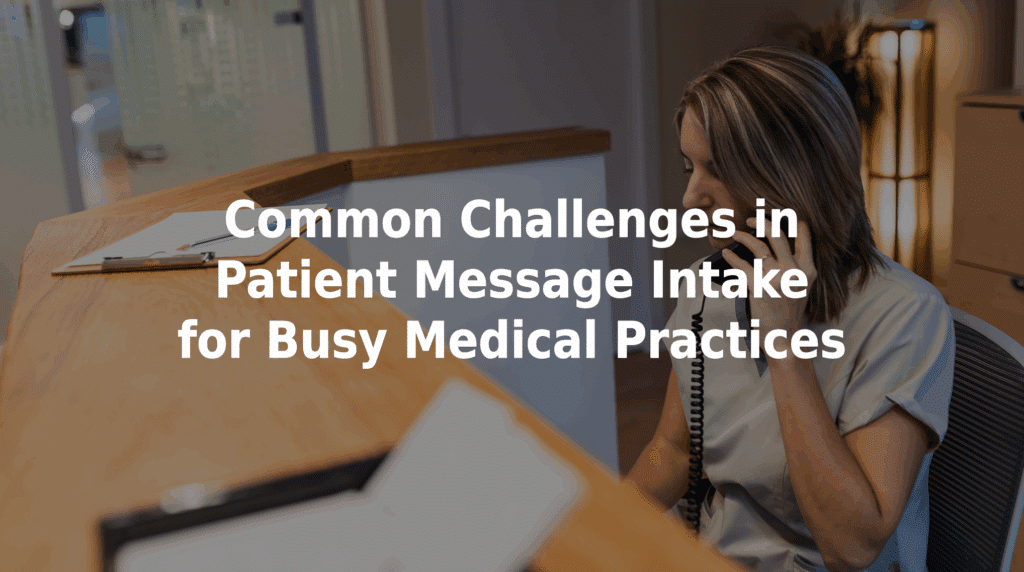Common Challenges in Patient Message Intake for Busy Medical Practices
Patient message intake is a critical part of care delivery, yet busy medical practices often struggle to collect accurate, actionable information during patient calls. These challenges can delay care, increase staff stress, and lower patient satisfaction. Below, we explore the common challenges in patient message intake for busy medical practices, and how our automated solution can address them.
1. Untrained or Overwhelmed Front Desk Staff
Most intake calls are initially handled by nonclinical operators, such as front desk staff or call center personnel. These employees may lack the clinical background to know what questions to ask or how to interpret reported symptoms. When they’re also juggling in-person patient needs, appointment scheduling, and insurance verifications, patient message requests can often be rushed or incomplete — leading to potential clinical oversight.
2. Patients Struggle to Clearly Communicate Their Concerns
Patients may not use medical terminology or may downplay serious symptoms during phone calls. Without structured prompts, nonclinical staff can misinterpret or omit important health information.
As one example, a 72-year-old woman called after hours asking for a prescription refill for vertigo. While the nonclinical operator treated the request as routine, an experienced nurse manager noticed the message and called the patient back, only to uncover additional symptoms — right arm weakness and headache — that indicated a possible stroke. Without this second layer of review, the patient’s health could have deteriorated quickly.
3. Lack of Standardized Intake Formats
Inconsistent message documentation is another challenge for practices. Operators often rely on free-text entry, which means that what gets recorded and passed along to clinical teams may vary widely based on user. Important symptoms may be buried in long messages or omitted entirely.
When you consider that one in 10 patient safety incidents that happen in hospitals are attributed to poor communication, it becomes clear that the accuracy of message intake must also be addressed to promote better health.
4. Call Volume and Time Constraints
High call volumes during peak hours can force staff to rush through intake, skip clarifying questions, or delay message delivery altogether. Practices that are already stretched thin can’t afford to let this impact their patient care.
Best Practice: Implement a secure digital intake that can reduce phone traffic and make sure that symptom details are recorded accurately and promptly.
5. Poor EHR Integration
Many practices still manually transcribe intake messages into their EHRs. This increases the chances of error, adds to clinician workload, and delays access to critical patient data. Systems that don’t communicate well with EHRs slow down clinical workflows and may require redundant data entry.
6. Limited Visibility for Clinical Teams
Clinicians and nurses often don’t see original intake messages, only summaries or relayed information. This lack of transparency can affect the accuracy of diagnoses, triage decisions, and follow-up plans.
Structured, shareable message formats that include screening responses directly from patients can prevent details from being lost in translation.
Reduce Intake Errors With Better Tools
If your practice is struggling with inconsistent intake, patient communication, or staff overload, it may be time to explore a digital solution that can reduce manual requirements and improve message accuracy. Here’s how your team can save time and reduce patient risk by streamlining communication from the start.
TriageLogic’s MedMessage Automate: How it Benefits Intake
MedMessage Automate empowers practices by offering patients a secure way to self-report their symptoms through a secure chatbot. Nonclinical staff no longer have to capture every detail manually, and patients can share their symptoms directly with providers. Staff gain more time to focus on in-person care, and clinical teams receive clear, actionable information — all integrated into your workflow.
If you’d like to see how this could benefit your team, contact us today to schedule a free demo!



